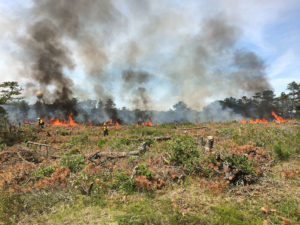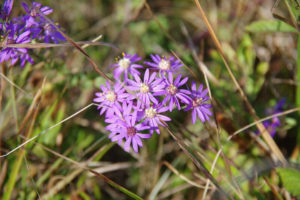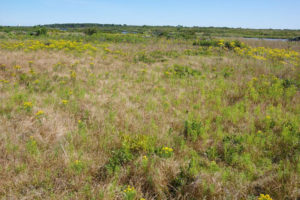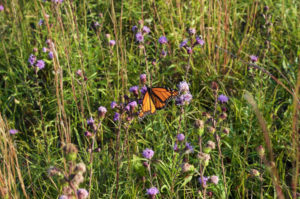Prescribed Fire in Existing Grassland
Prescribed fire can be used to maintain disturbance-adapted sandplain grasslands by manipulating ecological succession. The principal goals of grassland management with prescribed fire are to reduce woody vegetation cover, create conditions that maintain plant and animal species that rely on grassland habitat, alter soil conditions and microclimate, and reduce fuels and fire risk.
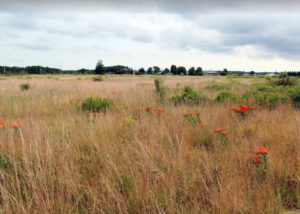
Figure 1. A 280-acre area of grassland managed by controlled burning at Camp Edwards in on Cape Cod. Photo from July 2016, two years after a fire treatment. Photo Credit: Jake McCumber.
Prescribed fire in sandplain grasslands typically aims to promote a diverse assemblage of target grassland species with a high proportion of warm-season grasses and native forbs, and a low proportion of cool season grasses and non-native invasive species, while reducing the regrowth of woody shrubs (Fig. 1). Prescribed fire can also maintain low fuel loads on a short-time basis, which can reduce fire hazards in some situations. Prescribed fire can also expose mineral soils, and maintain microclimates that foster germination and regeneration of fire-adapted or disturbance-dependent grassland species.
The behavior and consequences of prescribed fire for maintaining sandplain grassland vegetation can vary widely and depend on site conditions such as vegetation composition and structure, soils, climate, weather, fuel conditions, ignition patterns and techniques at the time of the fire, and applied fire variables such as seasonality and frequency at which prescribed fires are conducted. The use of prescribed fire exhibits logistical constraints that can hinder or prevent its use. Unpredictable weather, cost, manpower, local and regional regulations, smoke, health concerns, and perceived risk can all influence the effectiveness of burns by limiting options for applying prescribed fire. Management experience with fire and carefully planned experimental fire treatments during the last several decades provide rich information on fire effects in sandplain grasslands. Management of sandplain grasslands using fire can be complex and influenced by conditions that change on a daily or even hourly basis.
In this document, we evaluate the effects of prescribed fire in sandplain grassland compiled from published and unpublished studies and information obtained from Interviews with land managers. We focused on the following main questions relevant for sandplain grasslands management:
1) Does fire reduce woody growth?
2) Does fire maintain or increase grassland associated plant and animal species diversity?
3) Under which conditions is fire more or less effective at reducing woody species cover?
4) How can the effectiveness of prescribed fire be improved as a management tool to maintain sandplain grassland?
We focus on interpreting the main patterns that emerge from examining multiple experiences across multiple sites, with the understanding that responses to any one fire treatment under particular conditions may differ.
These studies represent only a portion of possible treatments and variables that could be tested. It is challenging to design and execute well-controlled studies to determine the impacts of management techniques on sandplain grassland when considering the combinations of individualistic species responses, treatments, short and long-term effects, and the number of replicates needed for sound investigations (Dunwiddie 1990).
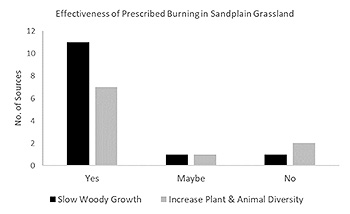
Figure 2. Number of sources that found prescribed fire in sandplain grasslands reduced woody shrub and tree regrowth.
Methods
We reviewed 75 sources that described or documented results of management actions in sandplain grasslands. Of these, 39 sources contained information on prescribed burning and 19 detailed specific management experiments or case studies. In addition, we Interviewed 13 professionals throughout the region about their experiences with prescribed fire in sandplain grasslands. Literature sources that tested active management treatments were classified by whether they: (A) reduced regrowth of woody vegetation and (B) increased biodiversity of plants or animals, or both (Fig. 2).
This review of literature and interviews is used to summarize the state of current management understanding of fire regimes in sandplain grasslands and the effects of prescribed fire on: (1) fuels and soils, (2) vegetation composition, (3) vegetation structure, and (4) fauna in relation to seasonality and fire frequency. We then suggest ways that the use of fire could be improved to decrease woody cover, increase graminoid cover, and maintain and promote biodiversity in sandplain grasslands.
Results
Overall, a large majority of sources found that prescribed fire reduced the regrowth of woody vegetation and increased biodiversity in some manner (Fig. 2). However, no study found that fire alone was completely effective over the long term in reducing woody regrowth or increasing biodiversity. Rather, our review found that most sources concluded that pairing fire with other management practices will be needed to control woody regrowth and maintain sandplain grassland biodiversity over the long term.
Logistical and Practical Constraints on the Use of Fire
While prescribed fire can often be effective for maintaining sandplain grasslands and species targeted for conservation, this management can also be complicated to implement. Implementing an ecologically effective fire regime can be constrained by costs, unpredictable weather, local regulations, smoke impacts, health issues, and perceived risk. Air quality can be affected in surrounding areas depending on atmospheric conditions. These constraints are exacerbated because sandplain grasslands are concentrated in coastal regions, which are tourist destinations and near the public. Smoke management typically limits the application of prescribed fire during summer, which is when ecological benefits of fire management can be greatest (J. Carlson, Interview). Burning when the drought index is high, which also enhances desired effects on vegetation, often requires increased monitoring and mop-up to mitigate smoldering and smoke impacts (J. Carlson, Interview). Smoldering combustion is influenced by on-site conditions and weather, is the most inefficient type of combustion, and produces the highest amounts of pollutants (J. Carlson, Interview).
Although applying fire during particular times of stress (e.g. droughts or outbreaks of herbivorous insects) could increase the effects of fire and reduce the frequency of fires required to obtain similar vegetation responses, being able to take advantage of these events in particular places will likely be challenging.
The effects of fire on vegetation structure in sandplain grassland and effects of fire frequency and seasonality have been studied in field management experiments. Summer fires during drought conditions most effectively reduce woody vegetation, woody debris, thatch, and duff, which exposes mineral soil and favors warm-season grasses and native forbs and discourages cool-season grasses and non-native invasive species. Spring fires can also promote warm season grasses. Summer fires consistently reduced woody growth only when they were conducted within a frequency every two to five years. Fire seasonality largely controls the effects on individual species and the resulting community. Early growing season fire typically favors warm-season, fire-tolerant native grasses and negatively affects fire-intolerant cool-season, and often non-native, grasses. Further, spring burns tend to stimulate growth of some forbs, while summer burns stimulate growth of warm season grasses. Much less is known about the effects of fire on fauna, but burning a mosaic of patches is recommended.
A major challenge for the use of fire for long-term management of sandplain grassland is the ability to apply it frequently enough, and to apply it in summer, or during conditions of drought, defoliation, or other stresses when its ecological effects are greatest.
This review identified several major ways to improve understanding of potential benefits of the use of fire for sandplain grassland management.
(1) Test combinations of fire with mowing or other management techniques. They should be designed and monitored as field experiments. This approach could potentially maintain the beneficial effects of fire in creating microclimate and soil conditions that promote target forb and warm-season grass species and limit growth of woody plants even when it its impractical to apply fire frequently enough during summer to restrict woody regrowth with fire alone. These combinations could be tested as sub-plots that are mowed or receive vegetation removal within larger areas that are currently being managed with prescribed fire at some intervals.
(2) Improve understanding of how infrequent or rare plants respond to different fire regime combinations. These rarer plants are some of the major targets for sandplain grassland management and often have life histories that differ from closely-related but more common species. There is currently almost no information on how these species respond to fire and the effects of fire seasonality, intensity or frequency applied to sandplain grassland.
(3) More work is needed to determine how prescribed fire affects the mortality and population dynamics of fauna in sandplain grassland. These effects may be particularly important for less common and conservation target species that have small, declining and dispersed populations. It is also important for higher-profile species such as birds and for more common species such as some invertebrates that are important prey of grassland birds.
References
Dudley, J.L., & Lajtha, K. 1993. The effects of prescribed burning on nutrient availability and primary production in sandplain grasslands. The American Midland Naturalist 130: 286–298.
Dunwiddie, P.W. 1991. Comparison of aboveground arthropods in burned, mowed and untreated sites in Sandplain Grasslands on Nantucket Island. The American Midland Naturalist 125: 206–212.
Dunwiddie, P.W. 1998. Ecological management of sandplain grasslands and coastal heathlands in southeastern Massachusetts. In Pruden, T.L. & Brennan, L.A. (eds.), Tall Timbers Fire Ecology Conference Proceedings, N. 20, pp. 83–93. Island Press, Tall Timbers Research Station, Tallahassee, FL.
Dunwiddie, P.W. 1990. Priorities and progress in management of sandplain grasslands and coastal heathlands in Massachusetts. Nantucket, MA. Report, unpublished.
Dunwiddie, P.W., & Caljouw, C. 1990. Prescribed burning and mowing of coastal healthlands and grasslands in Massachusetts. In Mitchell, R.S., Sheviak, C.J., & Leopold, D.J. (eds.), Proceedings of the 15th Annual Natural Areas Conference, New York State Museum Bulletin 471, pp. 271–275.
Dunwiddie, P.W., Patterson III, W.A., & Zaremba, R.E. 1995. Evaluating changes in vegetation from permanent plots: An example from sandplain grasslands in Massachusetts. In Herman, T.B., Bondrup-Nielsen, S., Martin Willison, J.H., & Munro, N.W.P. (eds.), Ecosystem Monitoring and Protected Areas, pp. 245–250. Science and Management of Protected Areas Association, Science and Management of Protected Areas Association, Wolfville, Nova Scotia.
Farnsworth, E.J. 2007. Plant life history traits of rare versus frequent plant taxa of sandplains: Implications for research and management trials. Biological Conservation 136: 44–52.
Freeman, R.S., Steinauer, E.M., & Treanor, S.A. 2005. The effect of management on the state-listed endangered species Symphyotrichum concolor (Asteraceae) on Nantucket Island. Nantucket, MA. Unpublished report submitted to Nantucket Conservation Foundation.
Hesling, J.L., & Grese, R.E. 2010. Assessing plant community changes over sixteen years of restoriation in a remnant Michigan tallgrass prairie. American Midland Naturalist 164: 322–336.
Karberg, J.M. 2014. Prescribed fire management in sandplain grasslands and heathlands: impacts of burn seasonality and intensity on vegetation composition, Head of the Plains, Nantucket MA. Nantucket, MA. Report, Unpublished.
Karberg, J.M. 2013. Sanford Farm and Ram Pasture property monitoring: Comparing the effects of long term annual mowing and prescribed fire management techniques on the presence of desirable sandplain grassland and sandplain heathland plants at Sanford Farm and Ram Pasture. Nantucket, MA. Internal Report, Unpublished, Nantucket Conservation Foundation.
Keeley, J.E., Aplet, G.H., Christensen, N.L., Conard, S.G., Johnson, E.A., Omi, P.N., Peterson, D.L., & Swetnam, T.W. 2009. Ecological foundations for fire management in North American forest and shrubland ecosystems. Portland, OR. Report (PNW-GTR-779), unpublished.
Leach, M.K., & Givnish, T.J. 1996. Ecological determinants of species loss in remnant prairies. Science 273: 1555–1558.
Martin, K.M. 2008. Disturbance-based management and plant species change in Massachusetts sandplain heathlands over the past two decades. University of Central Florida, Orlando, FL. M.S. Thesis, unpublished.
Neill, C., Von Holle, B., Kleese, K., Ivy, K.D., Collins, A.R., Treat, C., & Dean, M. 2007. Historical influences on the vegetation and soils of the Martha’s Vineyard, Massachusetts coastal sandplain: Implications for conservation and restoration. Biological Conservation 136: 17–32.
NWCG. (n.d.). Retrieved January 21, 2019, from https://www.nwcg.gov/glossary/a-z#Fire_Severity
Raleigh, L., Capece, J., & Berry, A. 2003a. Sand barrens habitat management: A toolbox for managers. Vineyard Haven, MA. Report, unpublished.
Raleigh, L., Vernegaard, L., Egan, C., Kennedy, C., & Bellinicampi, S. 2003b. Long Point Wildlife Refuge management plan.
Revised management plan for the Katama Plains Conservation Area. 2000. Edgartown, MA. Unpublished report to The Nature Conservancy.
Vickery, P.D. 2002a. Effects of prescribed fire on the reproductive ecology of northern blazing star Liatris scariosa var. novae-angliae. The American Midland Naturalist 148: 20–27.
Vickery, P.D. 2002b. Effects of the size of prescribed fire on insect predation of northern blazing star, a rare grassland perennial. Conservation Biology 16: 413–421.
Zuckerberg, B., & Vickery, P.D. 2006. Effects of mowing and burning on shrubland and grassland birds on Nantucket Island, Massachusetts. The Wilson Journal of Ornithology 118: 353–363.
Other Sources
Buelow, Chris. Interviewed by Lena Champlin. November 20, 2016.
Carlson, Joel. Interviewed by Lena Champlin. December 21, 2016.
Crary, David. Interviewed by Lena Champlin. December 6, 2016.
Goldstein, Paul. Interviewed by Lena Champlin. December 11, 2016.
Jones, Mike. Interviewed by Lena Champlin. November 20, 2016.
McCumber, Jake. Interviewed by Lena Champlin. November 8, 2016.
Mello, Mark. Interviewed by Lena Champlin. December 10, 2016.
Patterson III, William. Interviewed by Lena Champlin. December 13, 2016.
Scanlon, John. Interviewed by Lena Champlin. November 20, 2016.
Sferra, Nancy. Interview by Lena Champlin. November 17, 2016.
Simmons, Tim. Interviewed by Lena Champlin. December 14, 2016.
Vitz, Drew. Interviewed by Lena Champlin. November 20, 2016.
Wernerehl, Robert. Interviewed by Lena Champlin. November 20, 2016.


